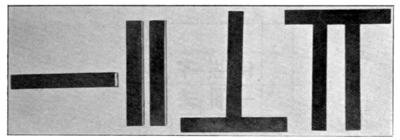The number 38057, for example, would be represented thus:
| A table should appear at this position in the text. See Help:Table for formatting instructions. |
The number 1267, represented by the sangi without the ruled board. Is shown in Fig. 7.

Fig. 7. The number 1297 represented by sangi.
From representing the numbers by the sangi on a ruled board came a much later method of transferring the lines to paper, and using a circle to represent the vacant square. This could only have occurred after the zero had reached China and had been passed on to Japan, but the date is only a matter of conjecture. By this method, instead of having 38057 represented as shown above, we should have it written thus:
In laying down the rods a red piece indicated a positive number and a black one a negative. In writing, however, a marked placed obliquely across a number indicated subtraction. Thus, (![]() symbol characters) meant (
symbol characters) meant (![]() symbol characters) 3, and (
symbol characters) 3, and (![]() symbol characters) meant (
symbol characters) meant (![]() symbol characters) 6.
symbol characters) 6.
The use of sangi in the fundamental operations may be illustrated by the following example in which we are required
